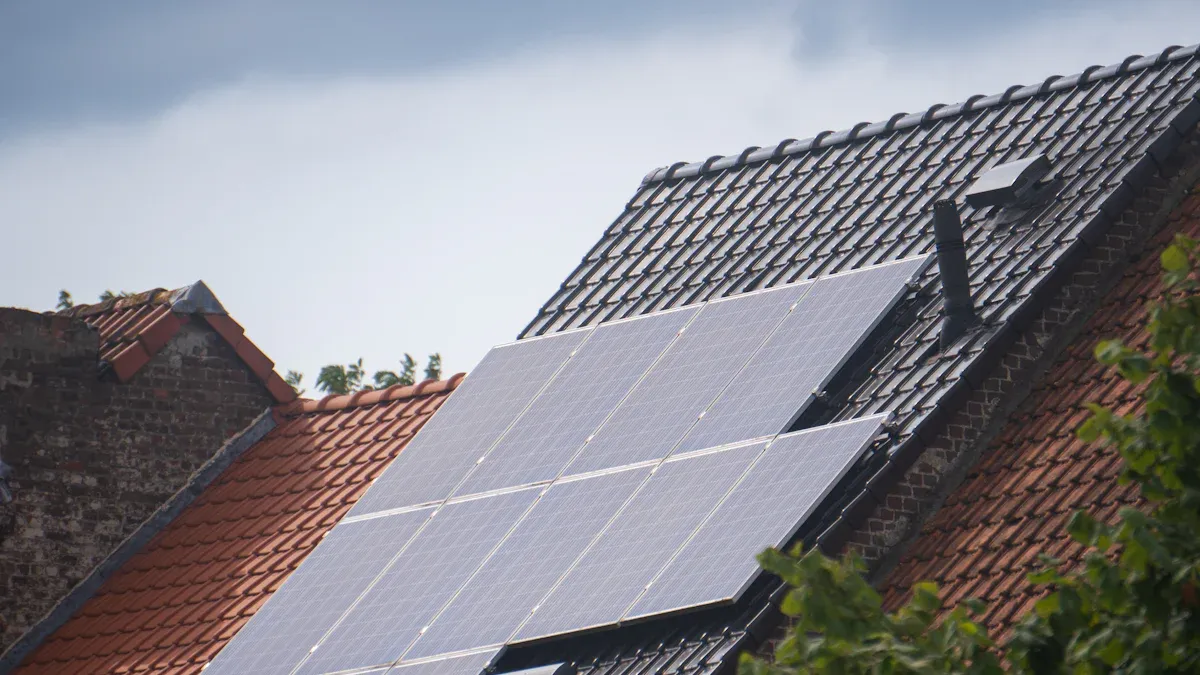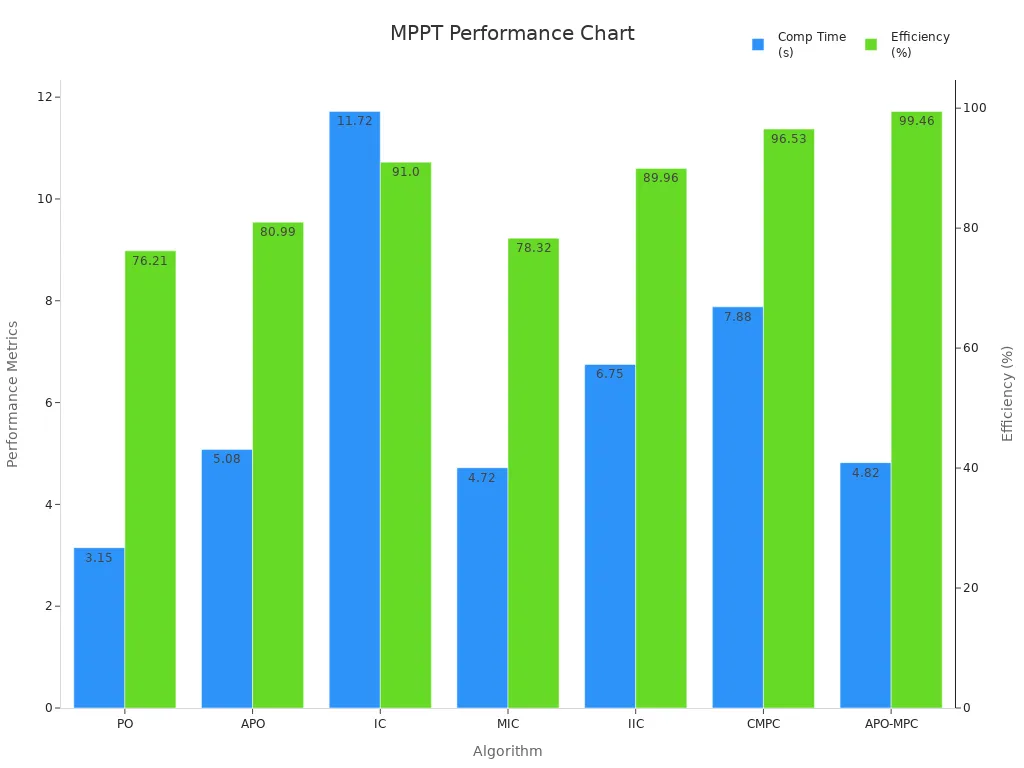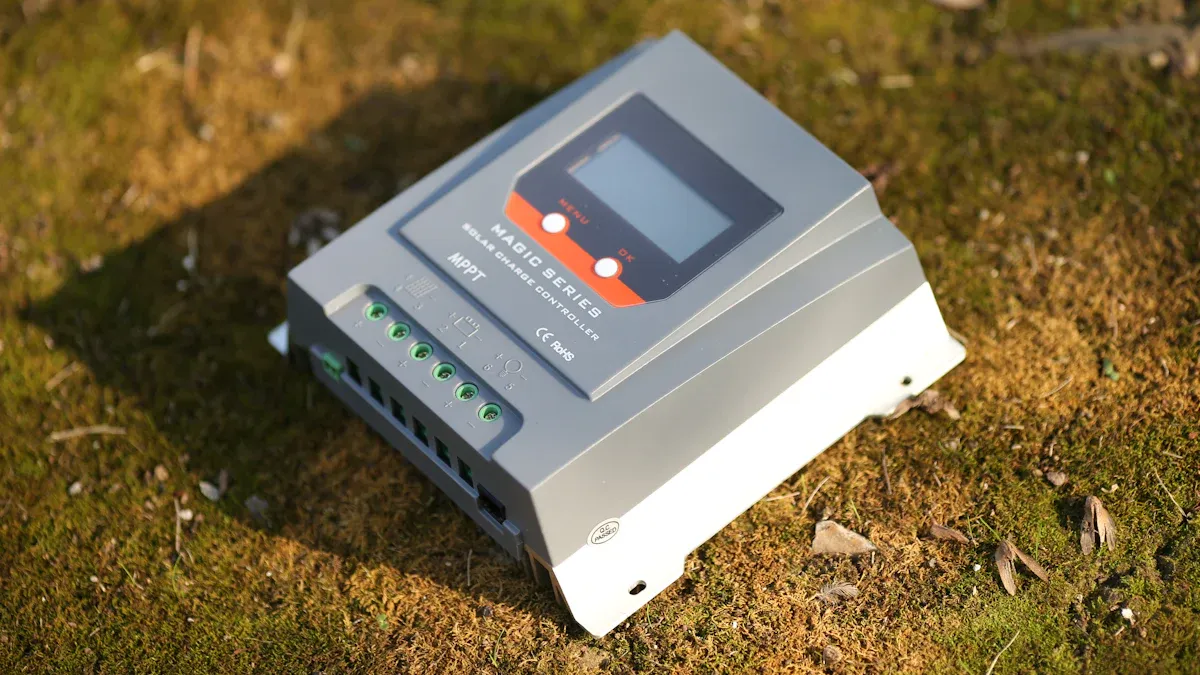How to Maximize Solar Energy with ESTEL MPPT Technology in 2025

Are you ready to unlock the true potential of your solar power system? ESTEL’s mppt controller brings cutting-edge optimization to your solar energy output. It ensures maximum power output by boosting solar energy efficiency and enabling optimal power generation. With ESTEL, you’ll achieve unmatched energy production and performance in your solar power systems.
Key Takeaways
MPPT technology improves solar energy use by up to 30%. Switch to an MPPT controller for more power.
ESTEL's smart systems adjust quickly to weather changes. They help solar panels work well, even on cloudy days.
Taking care of your solar system is important. Clean the panels and check wires every six months to keep them working well.
Understanding MPPT Technology
What Is MPPT and Its Role in Solar Energy Systems?
MPPT, or Maximum Power Point Tracking, is a smart technology that helps you get the most out of your solar panels. It works by adjusting the electrical operating point of your panels to ensure they produce the maximum possible power. Think of it as a fine-tuned system that constantly monitors and optimizes your solar energy output, even when conditions like sunlight intensity or temperature change.
Unlike traditional methods, MPPT technology is up to 30% more efficient than PWM controllers, especially in variable conditions. This makes it ideal for larger solar energy systems where maximizing output is critical. By continuously tracking the maximum power point, MPPT ensures your solar panels operate at their peak performance, delivering reliable energy for your home or business.
Tip: If you're looking to upgrade your solar system, choosing an MPPT solar charge controller is a smart move. It’s designed to handle fluctuations in sunlight and temperature, ensuring consistent energy production.
How Does a MPPT Charge Controller Work?
So, how does a MPPT charge controller work? It’s simpler than you might think. The controller calculates power output using voltage and current measurements (P = V × I). Then, it uses advanced algorithms to find the optimal operating point for your solar panels. This process is called maximum power point tracking, and it’s the secret sauce behind MPPT technology.
Here’s a quick breakdown of how MPPT works:
The controller continuously monitors the solar panel’s output.
It adjusts the current and voltage to match the battery’s charging needs.
Techniques like Perturb and Observe (P&O) or Incremental Conductance (INC) are used to make iterative adjustments.
These adjustments ensure your solar panels are always operating at their best, even when environmental conditions change. For example, if a cloud passes overhead, the MPPT charge controller adapts in real-time to maintain efficiency.
Note: Research shows that MPPT controllers can enhance power harvesting by 62% compared to direct coupling methods. That’s a huge boost in energy efficiency!
Why MPPT Is Essential for Maximizing Solar Energy Output
MPPT technology is a game-changer for solar power management. It’s essential because solar energy output fluctuates with environmental conditions like sunlight intensity, shading, and temperature. Without MPPT, your solar panels might not operate at their full potential, leaving valuable energy untapped.
Studies confirm that MPPT controllers outperform traditional PWM controllers by approximately 39% under varying conditions. They achieve this by continuously adjusting the operating voltage and current of your solar panels. Advanced methods like Particle Swarm Optimization (PSO) and Fuzzy Logic Control (FLC) further enhance performance, ensuring quick convergence to the maximum power point.
Here’s a snapshot of how different MPPT algorithms compare in terms of efficiency and computational time:
Algorithm | Average Computational Time (s) | Efficiency (%) |
|---|---|---|
PO | 3.15 | 76.21 |
APO | 5.08 | 80.99 |
IC | 11.72 | 91.00 |
MIC | 4.72 | 78.32 |
IIC | 6.75 | 89.96 |
CMPC | 7.88 | 96.53 |
APO-MPC | 4.82 | 99.46 |

As you can see, algorithms like APO-MPC maintain a tracking efficiency of over 99%, making them ideal for maximizing solar energy output. Whether you’re dealing with complex shading conditions or rapid changes in sunlight, MPPT technology ensures your solar system stays efficient and reliable.
Callout: MPPT isn’t just about efficiency; it’s about smarter solar power management. By leveraging advanced algorithms and real-time adaptability, MPPT technology helps you make the most of your solar investment.
How ESTEL MPPT Solar Charge Controllers Work

Advanced Algorithms for Maximum Power Point Tracking
When it comes to squeezing every drop of energy from your solar panels, ESTEL’s advanced algorithms are the real MVPs. These algorithms are designed to pinpoint the maximum power point of your solar panels with incredible precision. By doing so, they ensure your system operates at peak efficiency, no matter the conditions.
What makes these algorithms so effective? They rely on cutting-edge techniques like Perturb and Observe (P&O) and Incremental Conductance (IC). These methods continuously adjust the voltage and current to match the optimal operating point of your panels. But ESTEL takes it a step further by incorporating enhancements like Adaptive Perturb and Observe (APO) and Model Predictive Control (MPC). These upgrades allow for faster and more accurate tracking, even in challenging environments.
Here’s a quick look at how ESTEL’s algorithms compare to traditional methods:
Feature | Traditional Methods | ESTEL’s Advanced Algorithms |
|---|---|---|
Speed of Adjustment | Moderate | Fast |
Accuracy in Maximum Power Point | Good | Excellent |
Adaptability to Changing Conditions | Limited | High |
By using these advanced algorithms, ESTEL ensures your solar panels deliver maximum output, even when the weather isn’t cooperating. Whether it’s a cloudy day or a sudden temperature drop, you can count on your system to keep performing at its best.
Tip: If you’re upgrading your solar energy system, look for a solar charge controller with advanced tracking algorithms. It’s a game-changer for efficiency and reliability.
Real-Time Adaptability to Environmental Conditions
Solar energy systems face constant challenges from changing environmental conditions. Clouds, shading, and temperature fluctuations can all impact your system’s performance. That’s where ESTEL’s MPPT solar charge controllers shine. They’re built to adapt in real time, ensuring your panels always operate at their maximum potential.
Imagine a cloud passing over your solar panels. Without real-time adaptability, your system might lose significant energy. But ESTEL’s controllers monitor the situation and adjust instantly. They tweak the voltage and current to maintain the maximum power point, so you don’t lose valuable output.
This adaptability isn’t just theoretical. ESTEL’s technology has been tested using wind turbine emulators, which simulate real-world conditions. These tests show that the controllers can optimize power extraction even in dynamic environments. Here’s what the research found:
Evidence Description | Findings |
|---|---|
Use of wind turbine emulator | Allows for real-time simulation and testing of control algorithms. |
Enhancements to the emulator | Facilitates the assessment of MPPT strategies for optimizing power output. |
With this level of adaptability, you can trust your solar system to perform consistently, regardless of the weather.
Callout: Real-time adaptability isn’t just a feature—it’s a necessity. It ensures your solar panels keep generating energy efficiently, even when conditions aren’t ideal.
Efficient Battery Charging and Energy Management
A great solar system doesn’t just generate energy; it manages it efficiently. ESTEL’s MPPT charge controllers excel in this area by optimizing battery charging and overall energy management. They ensure your batteries get charged quickly and safely, without overcharging or undercharging.
Here’s how it works: The controller adjusts the charging process based on the battery’s state of charge. When the battery is low, it delivers maximum current for fast charging. As the battery nears full capacity, the controller reduces the current to prevent damage. This smart charging process extends the life of your batteries and ensures they’re always ready to deliver power when you need it.
But that’s not all. ESTEL’s controllers also manage energy distribution efficiently. They prioritize critical loads and store excess energy for later use. This means you can rely on your system to power your home or business, even during peak demand.
Note: Efficient energy management isn’t just about saving power—it’s about making the most of every watt your solar panels produce.
Key Benefits of ESTEL MPPT Charge Controllers
Enhanced Energy Efficiency and Performance
When it comes to energy efficiency, ESTEL MPPT charge controllers are in a league of their own. These controllers can boost energy harvest by up to 30% compared to traditional PWM controllers. That’s a significant improvement, especially if you’re looking to maximize the output of your solar panels. By continuously tracking the maximum power point, they ensure your solar panels operate at their peak performance, even when sunlight conditions fluctuate.
This enhanced efficiency means you get more energy from the same number of solar panels. Whether you’re powering your home or a business, this translates to lower energy costs and a more sustainable system. With ESTEL’s advanced technology, you’re not just saving energy—you’re making the most of every ray of sunlight.
Tip: Upgrading to an MPPT solar charge controller is one of the easiest ways to improve the efficiency of your solar energy systems.
Compatibility with Various Solar Panel Configurations
One of the standout features of ESTEL MPPT charge controllers is their versatility. They’re designed to work seamlessly with a wide range of solar panel configurations. Whether you have a small residential setup or a large commercial installation, these controllers adapt to your system’s needs.
For instance, if you’re using panels with different voltage ratings or dealing with partial shading, ESTEL’s MPPT technology ensures optimal performance. This flexibility makes it easier to expand your solar system in the future without worrying about compatibility issues. You can mix and match panels to suit your energy requirements, and the controller will handle the rest.
Callout: Planning to upgrade or expand your solar panels? ESTEL MPPT charge controllers make it simple and hassle-free.
Smart Monitoring and Maintenance Features
Keeping your solar system running smoothly is easier with ESTEL’s smart monitoring features. These MPPT charge controllers come equipped with advanced diagnostics and real-time data tracking. You can monitor your system’s performance, identify issues early, and ensure everything is working efficiently.
The controllers also provide detailed insights into your solar panels’ output, battery status, and overall energy usage. This level of transparency helps you make informed decisions about your energy consumption. Plus, with automated maintenance alerts, you’ll always know when it’s time for a check-up.
Note: Smart monitoring isn’t just convenient—it’s essential for maintaining the long-term health of your solar energy systems.
Tips for Maximizing Solar Energy with ESTEL MPPT Technology

Optimizing System Setup and Configuration
Getting the most out of your solar energy systems starts with a proper setup. Begin by ensuring your solar panels are positioned to capture maximum sunlight throughout the day. South-facing panels with the correct tilt angle often yield the best results. Pairing your panels with an ESTEL mppt charge controller ensures that your system operates at peak efficiency by continuously tracking the maximum power point.
Next, check the compatibility of your solar charge controller with your solar panel configuration. ESTEL’s controllers work seamlessly with various setups, whether you have a small residential system or a large commercial installation. Proper wiring and connections also play a crucial role in system performance. Loose or faulty connections can reduce energy output, so double-check everything during installation.
Tip: Use ESTEL’s smart monitoring features to fine-tune your system setup. They provide real-time data to help you identify and fix inefficiencies quickly.
Regular Maintenance and Performance Checks
Keeping your solar energy systems in top shape requires regular maintenance. Cleaning your panels is essential since dirt and debris can block sunlight and reduce efficiency by up to 25%. Schedule routine inspections to identify potential issues before they escalate. Electrical checks ensure your system operates safely and efficiently, while inverter maintenance helps maintain durability.
Managing vegetation around your panels is equally important. Overgrown plants can cause shading, which lowers energy output. Studies show that well-maintained systems can operate at over 90% of their original efficiency, even after 20 years. Comprehensive maintenance can also improve your system performance ratio from 92% to over 95%.
Callout: Proper upkeep not only maximizes energy production but also extends the lifespan of your solar panels and components.
Leveraging ESTEL's Smart Features for Peak Efficiency
ESTEL’s mppt charge controller comes packed with smart features designed to optimize system performance. Use the real-time monitoring tools to track energy output and identify inefficiencies. These tools provide detailed insights into your solar panels, battery status, and overall energy usage, helping you make informed decisions.
Take advantage of automated maintenance alerts to stay on top of system upkeep. These alerts notify you when it’s time for cleaning, inspections, or repairs, ensuring your system always operates at peak efficiency. Additionally, ESTEL’s advanced algorithms adapt to changing environmental conditions, so your system delivers consistent performance regardless of weather fluctuations.
Note: Leveraging these smart features not only boosts efficiency but also simplifies the management of your solar energy systems.
ESTEL MPPT charge controllers redefine how you harness solar energy. They boost efficiency, adapt to changing conditions, and keep your batteries reliable. If you want to maximize your system’s potential, now’s the time to upgrade. Take control of your energy future with ESTEL’s innovative technology. Your solar system deserves it!
FAQ
1. What makes ESTEL MPPT controllers better than traditional PWM controllers?
ESTEL MPPT controllers are up to 30% more efficient. They track the maximum power point, ensuring your solar panels operate at peak performance, even in changing conditions.
Tip: Upgrade to MPPT controllers for better energy output and long-term savings.
2. Can ESTEL MPPT controllers work with older solar panel systems?
Yes! ESTEL MPPT controllers are compatible with various configurations, including older systems. They adapt to different voltage ratings and optimize performance for maximum energy efficiency.
3. How often should I maintain my solar system with ESTEL MPPT technology?
Perform maintenance every 6 months. Clean panels, inspect wiring, and check battery health. Use ESTEL’s smart monitoring tools to track performance and receive automated maintenance alerts.
Note: Regular upkeep ensures your system stays efficient and lasts longer.
See Also
Innovative Energy Storage Solutions for Telecom Cabinets in 2025
Solar-Powered Energy Storage Systems for Communication Cabinets
Eco-Friendly Outdoor Telecom Cabinets Designed for Future Needs
CALL US DIRECTLY
86-13752765943
3A-8, SHUIWAN 1979 SQUARE (PHASE II), NO.111, TAIZI ROAD,SHUIWAN COMMUNITY, ZHAOSHANG STREET, NANSHAN DISTRICT, SHENZHEN, GUANGDONG, CHINA

